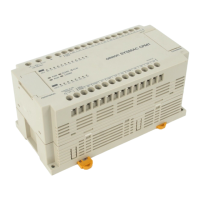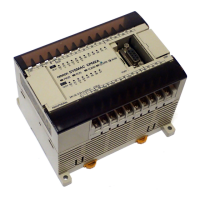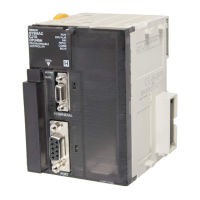137
Only one JME(005) instruction per jump number should be used in a program. If
two or more JME(005) instructions with the same jump number are used in a
program, program execution will skip to the JME(005) instruction at the lowest
program address, even if it precedes the JMP(004) instruction. Programming
multiple JMP(005) instructions for the same JME(004) instruction can be useful
in programming.
Differentiation in Jumps Although DIFU(013) and DIFD(014) are designed to turn ON the designated bit
for one cycle, they will not necessarily do so when written between JMP(004)
and JME(005). Once DIFU(013) or DIFD(014) has turned ON a bit, it will remain
ON until the next time DIFU(013) or DIFD(014) is executed again. In normal pro-
gramming, this means the next cycle. In a jump, this means the next time the
jump from JMP(004) to JME(005) is not made, i.e., if a bit is turned ON by
DIFU(013) or DIFD(014) and then a jump is made in the next cycle so that
DIFU(013) or DIFD(014) are skipped, the designated bit will remain ON until the
next time the execution condition for the JMP(004) controlling the jump is ON.
When DIFU(013), DIFD(014), or a differentiated instruction is executed in an
jumped section immediately after the execution condition for the JMP(004) has
gone ON, the execution condition for the DIFU(013), DIFD(014), or differen-
tiated instruction will be compared to the execution condition that existed before
the jump became effective (i.e., before the execution condition for JMP(004)
went OFF).
JUMP 0000 The PC Setup can be used to control the operation of jumps created using jump
number 0000. If multiple jumps with 0000 are disabled, jumps created with 0000
will operate as described above. If multiple jumps are enabled, any JMP 0000
instruction will jump to the next JME 0000 in the program (and not the first
JME 0000 in the program). When multiple jumps for 0000 are enabled, you can-
not overlap or nest the jumps, i.e., each JMP 0000 must be followed by a
JME 0000 before the next JMP 0000 in the program and each JME 0000 must
be followed by a JMP 0000 before the next JME 0000 in the program.
Even if the JMP condition is OFF, all instructions between JMP 0000 and
JME 0000 are still processed as NOPs, increasing the cycle time accordingly.
If the JMP condition is OFF when JMP 0001 through JMP 0999 are being used,
the program will jump directly to JME(005). Any instructions between JMP(004)
and JME(005) are not executed at all, and the cycle time is shortened according-
ly.
Precautions The jump number N must be BCD between 0000 and 0999.
When JMP(004) and JME(005) are not used in pairs, an error message will ap-
pear when the program check is performed. If a JME(005) instruction precedes
a JMP(004) instruction with the same jump number, a loop might occur, so the
END(001) instruction is never executed, causing a Cycle Time Over error.
Flags ER (A50003): Content of *DM word is not BCD when set for BCD.
Jump number is not BCD or not between 0000 and 0999.
JMP(004) in the program without a corresponding JME(005).
Also turns ON the Jump Error Flag A40213.
Example Examples of jump programs are provided in
4-6 Jumps
.
JUMP and JUMP END: JMP(004) and JME(005) Section 5-9

